
The globus pallidus (GP), also known as paleostriatum or dorsal pallidum, is a subcortical structure of the brain. It consists of two adjacent segments, one external, known in rodents simply as the globus pallidus, and one internal, known in rodents as the entopeduncular nucleus. It is part of the telencephalon, but retains close functional ties with the subthalamus in the diencephalon – both of which are part of the extrapyramidal motor system. The globus pallidus is a major component of the basal ganglia, with principal inputs from the striatum, and principal direct outputs to the thalamus and the substantia nigra. The latter is made up of similar neuronal elements, has similar afferents from the striatum, similar projections to the thalamus, and has a similar synaptology. Neither receives direct cortical afferents, and both receive substantial additional inputs from the intralaminar thalamus.

The indirect pathway, sometimes known as the indirect pathway of movement, is a neuronal circuit through the basal ganglia and several associated nuclei within the central nervous system (CNS) which helps to prevent unwanted muscle contractions from competing with voluntary movements. It operates in conjunction with the direct pathway.

The nucleus raphe pallidus receives afferent connections from the periaqueductal gray, the Paraventricular nucleus of hypothalamus, central nucleus of the amygdala, lateral hypothalamic area, and parvocellular reticular nucleus.

Gliophorus psittacinus, commonly known as the parrot toadstool or parrot waxcap, is a colourful member of the genus Gliophorus, found across Northern Europe. It was formerly known as Hygrocybe psittacina, but a molecular phylogenetics study found it to belong in the genus Gliophorus. It had already been placed in Gliophorus, but it had been considered a synonym of Hygrocybe.
The desert yellow bat is a species of vesper bat. It is found in India, Pakistan, and Bangladesh. Its natural habitats are subtropical or tropical dry forests and shrubland, rural gardens, and urban areas.

The external globus pallidus combines with the internal globus pallidus (GPi) to form the globus pallidus, an anatomical subset of the basal ganglia. Globus pallidus means "pale globe" in Latin, indicating its appearance. The external globus pallidus is the segment of the globus pallidus that is relatively further (lateral) from the midline of the brain.

The internal globus pallidus and the external globus pallidus (GPe) make up the globus pallidus. The GPi is one of the output nuclei of the basal ganglia. The GABAergic neurons of the GPi send their axons to the ventral anterior nucleus (VA) and the ventral lateral nucleus (VL) in the dorsal thalamus, to the centromedian complex, and to the pedunculopontine complex.

Gliophorus is a genus of agaric fungi in the family Hygrophoraceae. Gliophorus species belong to a group known as waxcaps in English, sometimes also waxy caps in North America or waxgills in New Zealand. In Europe, Gliophorus species are typical of waxcap grasslands, a declining habitat due to changing agricultural practices. As a result, two species, Gliophorus europerplexus and Gliophorus reginae, are of global conservation concern and are listed as "vulnerable" on the IUCN Red List of Threatened Species.
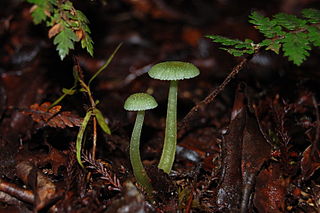
Gliophorus graminicolor is a species of agaric fungus in the family Hygrophoraceae. It is found in Australia and New Zealand. In 1995, Australian mycologists Tom May and Alec Wood transferred the species to Hygrocybe, but the taxonomic authority Index Fungorum retains it in Gliophorus.
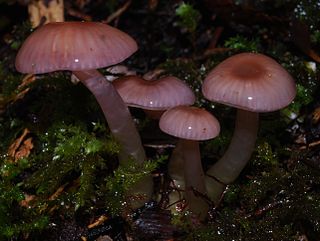
Gliophorus versicolor is a species of agaric fungus in the family Hygrophoraceae. Found in New Zealand, it was described as new to science in 1973 by mycologist Egon Horak. Within the genus Gliophorus, it is classified in the section Glutinosae, a grouping of species characterized by having bright colors, decurrent gills, and a gelatinized subhymenium. Fruit bodies have hemispherical to convex caps typically measuring 20 mm (0.8 in), although some have been recorded up to 50 mm (2.0 in). Moist caps are gluey with a color ranging from reddish brown to pinkish-lilac; the cap margin has radial grooves mirroring the gills underneath. The gills have an adnate to somewhat decurrent attachment to the stipe. They are widely spaced with color similar to the cap, or whitish. The cylindrical, hollow stipe measures 2–7 cm (0.8–2.8 in) by 1.5–3 mm (0.06–0.12 in) thick. The fungus is saprobic, and fruits on the ground among Dacrycarpus and Nothofagus.

Gliophorus lilacipes is a species of agaric fungus in the family Hygrophoraceae. Found in New Zealand, it was described by Egon Horak in 1973.
Gliophorus bichromus is a species of agaric fungus in the family Hygrophoraceae. Found in New Zealand, it was described by mycologist Egon Horak in 1973.

Gliophorus europerplexus is a species of agaric in the family Hygrophoraceae. It has been given the recommended English name of butterscotch waxcap. The species has a European distribution, occurring mainly in agriculturally unimproved grassland. Threats to its habitat have resulted in the species being assessed as globally "vulnerable" on the IUCN Red List of Threatened Species.

Gliophorus laetus is a species of agaric fungus in the family Hygrophoraceae. Originally described as new to science by Christian Hendrik Persoon in 1800, it was transferred to the genus Gliophorus in 1958. It is considered edible, but of little interest.
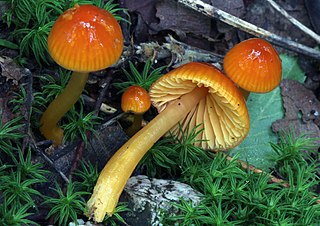
Gliophorus perplexus is a species of agaric fungus in the family Hygrophoraceae. It was first described in 1954 by American mycologists Alexander H. Smith and Lexemuel Ray Hesler as Hygrophorus perplexus.
Gliophorus pseudograminicolor is a species of agaric fungus in the family Hygrophoraceae. Found in Australia, it was originally described in 1997 by mycologist Anthony M. Young as a species of Hygrocybe and transferred to Gliophorus in 2013.

Gliophorus reginae is a species of agaric in the family Hygrophoraceae. It has been given the recommended English name of jubilee waxcap. The species has a European distribution, occurring mainly in agriculturally unimproved grassland. Threats to its habitat have resulted in the species being assessed as globally "vulnerable" on the IUCN Red List of Threatened Species.

Gliophorus viridis is a species of agaric fungus in the family Hygrophoraceae found in New Zealand and Australia.
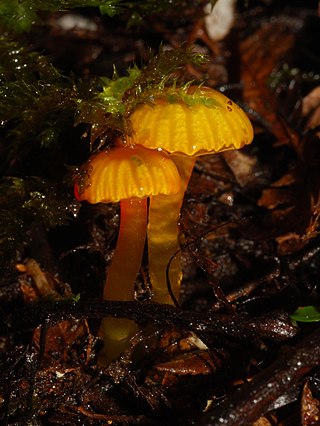
Gliophorus viscaurantius is a species of agaric fungus in the family Hygrophoraceae found in New Zealand.
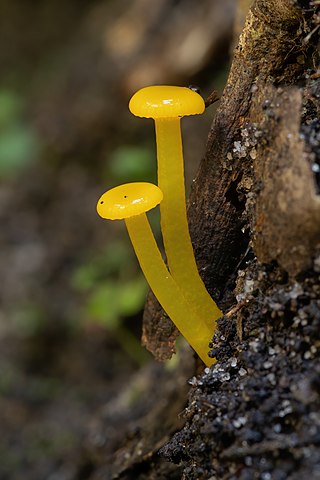
Gliophorus chromolimoneus is a species of agaric fungus in the family Hygrophoraceae found in New Zealand and Australia.















